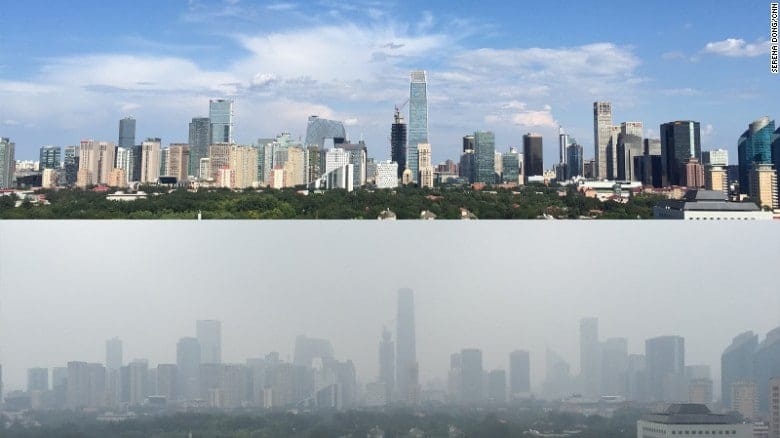July 16, 2018
A Breath of Fresh-er Air! Latest on Beijing's Air Quality
 2018 has seen a significant positive shift in attitudes toward environmental, water, and air pollution. In recent years China has been heavily scrutinised for its questionable air quality, as well as India and Poland. However, over the last year, Beijing has been quietly and rather effectively cleaning up its act.
2018 has seen a significant positive shift in attitudes toward environmental, water, and air pollution. In recent years China has been heavily scrutinised for its questionable air quality, as well as India and Poland. However, over the last year, Beijing has been quietly and rather effectively cleaning up its act.
 When you think of Beijing one of the very first things that often come to mind are pollution and smog. Well, over the past year Beijing has seen some incredible results in their steps to cleaning up its air and cutting down pollution.
So switch off your purifiers and crack open a window, its 2018 New Year - New Air! Fresh-er Air Quality! (Okay perhaps we’re getting a little ahead of ourselves)
When you think of Beijing one of the very first things that often come to mind are pollution and smog. Well, over the past year Beijing has seen some incredible results in their steps to cleaning up its air and cutting down pollution.
So switch off your purifiers and crack open a window, its 2018 New Year - New Air! Fresh-er Air Quality! (Okay perhaps we’re getting a little ahead of ourselves)
 In 2012 Beijing set out to reduce the level of PM 2.5 in the air from 90 to below 60 micrograms per cubic metre by 2017. Under the Environmental Ministry’s anti-pollution measures, factories producing heavily industrial materials such as cement and steel were urged to close or heavily curtail production within the Beijing province and 26 neighbouring cities, drastically reducing the volume of pollutants being pumped into the air.
It doesn’t stop there. Over the past 5 years, Beijing has closed down almost 2000 factories including coal-fired power plants and succeeded in eradicating 2 million high emission vehicles from the roads (although the amount of traffic is still questionable, to say the least). On the bright side, Beijing residents are now able to enjoy more blue-sky days in comparison to the years before.
China is not playing when it comes to winning the battle against pollution. In 2017 coal consumption in Beijing was close to none, resulting in 65% blue-sky days during December. Almost gone are the days of not being able to see the other side of the road as you walk to work.
In 2012 Beijing set out to reduce the level of PM 2.5 in the air from 90 to below 60 micrograms per cubic metre by 2017. Under the Environmental Ministry’s anti-pollution measures, factories producing heavily industrial materials such as cement and steel were urged to close or heavily curtail production within the Beijing province and 26 neighbouring cities, drastically reducing the volume of pollutants being pumped into the air.
It doesn’t stop there. Over the past 5 years, Beijing has closed down almost 2000 factories including coal-fired power plants and succeeded in eradicating 2 million high emission vehicles from the roads (although the amount of traffic is still questionable, to say the least). On the bright side, Beijing residents are now able to enjoy more blue-sky days in comparison to the years before.
China is not playing when it comes to winning the battle against pollution. In 2017 coal consumption in Beijing was close to none, resulting in 65% blue-sky days during December. Almost gone are the days of not being able to see the other side of the road as you walk to work.
 Though this journey to improvement hasn’t all been smooth sailing for Beijing. After the first 3 years of anti-pollution efforts, the capital had only reduced its average PM2.5 levels by 17%.
The road to success looked rough for Beijing, with only 1 year to achieve almost the same progress as 3 years their chances of winning looked about the same as Brazil’s chance of winning this year’s world cup. However, much like England, nobody expected them to perform as well as they have; in late 2017 they achieved their goal reducing PM2.5 to 58 micrograms per cubic metre, showing China’s hard work is paying off.
There is much further for Beijing to come, as at present the World Health Organisation’s acceptable level for PM2.5 currently stands at 10 micrograms per cubic metre. If Beijing follows the same progress it has had in the past year into the future, blue skies and easy breathing may just be here to stay!
By Andre Clacken-Lewin
Though this journey to improvement hasn’t all been smooth sailing for Beijing. After the first 3 years of anti-pollution efforts, the capital had only reduced its average PM2.5 levels by 17%.
The road to success looked rough for Beijing, with only 1 year to achieve almost the same progress as 3 years their chances of winning looked about the same as Brazil’s chance of winning this year’s world cup. However, much like England, nobody expected them to perform as well as they have; in late 2017 they achieved their goal reducing PM2.5 to 58 micrograms per cubic metre, showing China’s hard work is paying off.
There is much further for Beijing to come, as at present the World Health Organisation’s acceptable level for PM2.5 currently stands at 10 micrograms per cubic metre. If Beijing follows the same progress it has had in the past year into the future, blue skies and easy breathing may just be here to stay!
By Andre Clacken-Lewin












